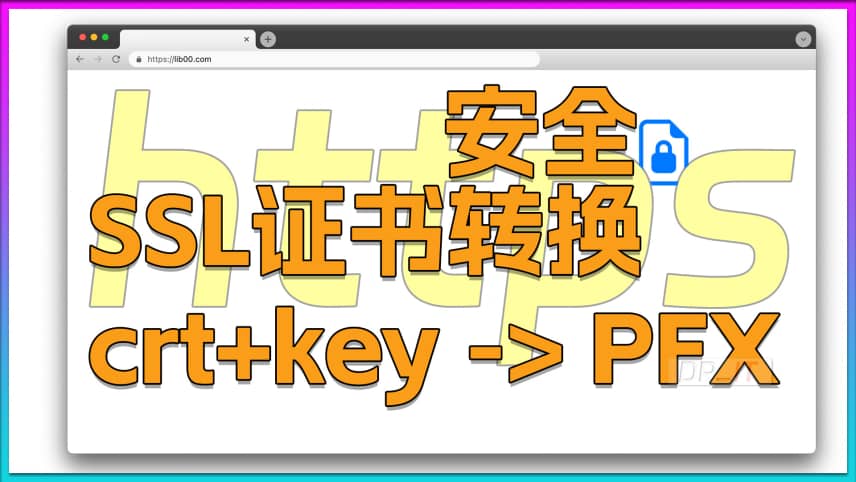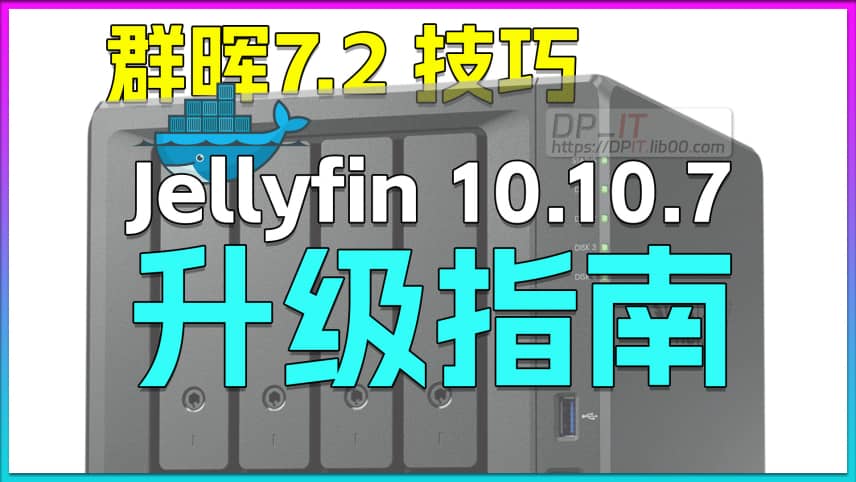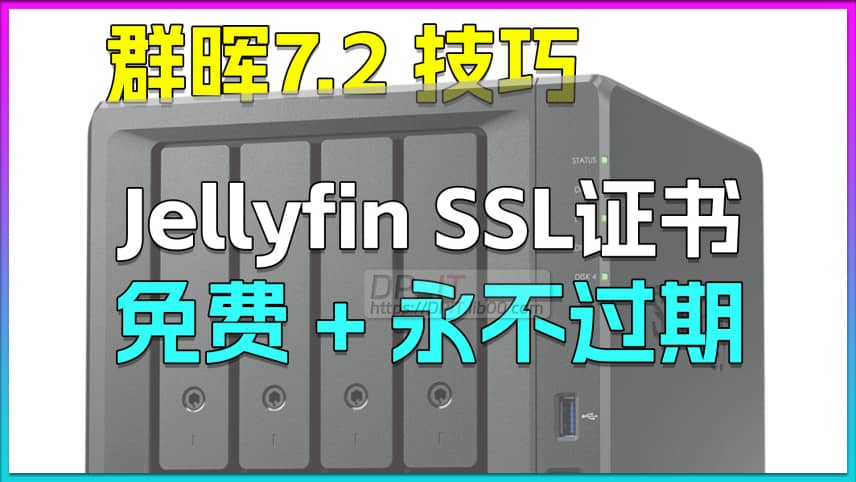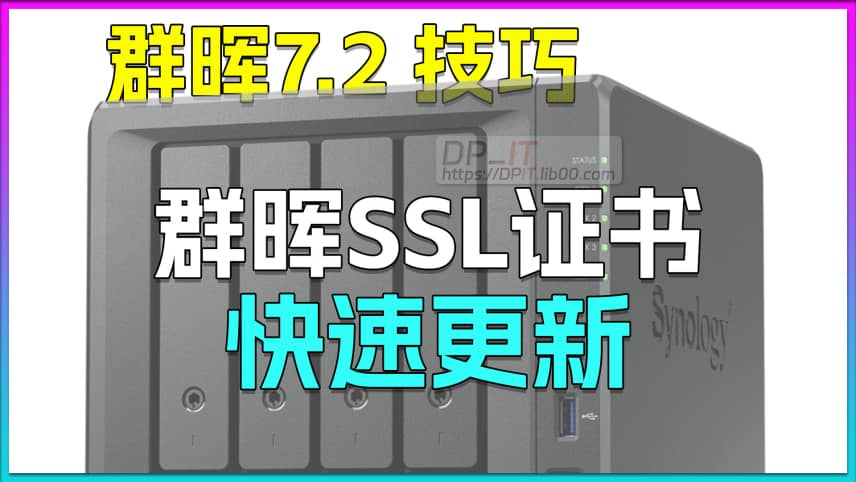
Convert CRT+KEY SSL Certificate to PFX Format
Support Content
## 1. Introduction
This video demonstrates a secure method for converting traditional SSL certificates in CRT and KEY format to PFX format.
Disclaimer: Released with DP_IT video, free to use. Any commercial activities such as resale are strictly prohibited. If someone sold this to you, please request a refund. Website: https://dpit.lib00.com
## 2. Command List
> All command lines used in the video are listed below and can be copied directly
> 1. Check OpenSSL version and whether it is installed
openssl version
> 2. Switch to the working folder, replace the path with your actual path
cd /volume1/eeTmp/t/ssl_to_pfx
### //All operations below are performed within the working folder
> 3. View certificate information
openssl x509 -in ./o/dpit-t2.lib00.com_bundle.crt -text -noout
> 4. Convert certificate crt+key => pfx
openssl pkcs12 -export -out encode_pfx_dpit-t2.pfx -inkey ./o/dpit-t2.lib00.com.key -in ./o/dpit-t2.lib00.com_bundle.crt -password pass:dpit2024
> 5. Convert pfx back to pem to test if the pfx certificate is valid
openssl pkcs12 -in encode_pfx_dpit-t2.pfx -clcerts -nokeys -out decode.pem -password pass:dpit2024
Summary Content
# Convert CRT+KEY SSL Certificate to PFX Format
## 📋 Video Overview
This video provides a comprehensive guide on how to securely convert SSL certificates from CRT and KEY format to PFX format. The author, DB, emphasizes the security risks involved in certificate conversion and presents two methods: direct download from cloud service providers and local generation using OpenSSL command-line tools.
---
## 🔐 Why This Video Was Created
When searching for certificate conversion tutorials online, the author discovered that most guides direct users to online conversion websites. This approach poses **serious security risks**:
- Users must upload their private KEY files to third-party websites
- Third parties gain access to both the CRT (public key) and KEY (private key)
- This is a **very dangerous operation** that could lead to certificate compromise
---
## 💡 Method 1: Direct Download from Cloud Provider (Recommended for Beginners)
**Use Case**: Quick PFX certificate acquisition without command-line operations
**Steps** (using Tencent Cloud as example):
1. Log into Tencent Cloud SSL Certificate Management Console
2. Locate your issued certificate and click "Download"
3. Select "PFX" format from the certificate format list (not Nginx format CRT+KEY)
4. Extract the downloaded file to get two files:
- `.pfx` certificate file
- `.txt` password file (randomly generated string)
**Advantages**:
- Simple operation, beginner-friendly
- Completely secure within cloud provider environment
- Automatically generates strong random password
---
## 🖥️ Method 2: Local Generation Using OpenSSL Command Line (Recommended for Advanced Users)
**Use Case**: Custom password requirement or server environment operations
### Prerequisites
1. **Download Certificate Files**: Obtain Nginx format certificate from cloud provider (.crt and .key files)
2. **Verify OpenSSL Installation**: Check if OpenSSL is installed on your server
3. **Prepare Working Directory**: Create a dedicated folder for certificate files
### Detailed Steps
**Step 1: Verify OpenSSL Installation**
```bash
openssl version
```
- Video tested two versions: Synology NAS (0.9.8) and macOS (3.1)
- Both versions work correctly
**Step 2: Navigate to Working Directory**
```bash
cd /volume1/Temp/t/ssl_to_pfx/
```
**Step 3: Verify CRT Certificate Validity**
```bash
openssl x509 -in o/your_domain.crt -text -noout
```
- This command checks if the certificate file is valid
- Displays detailed certificate information (domain, validity period, etc.)
**Step 4: Generate PFX Certificate (Core Command)**
**For OpenSSL 0.9.8 (e.g., Synology NAS):**
```bash
openssl pkcs12 -export -out your_domain_pfx.pfx -inkey o/your_domain.key -in o/your_domain.crt -passout pass:DPIT2024
```
**For OpenSSL 3.x (e.g., macOS):**
```bash
openssl pkcs12 -export -out your_domain_pfx.pfx -inkey o/your_domain.key -in o/your_domain.crt -legacy -passout pass:DPIT2024
```
**Command Parameter Explanation**:
- `-export`: Export PKCS12 format
- `-out`: Output PFX filename
- `-inkey`: Input private key file (.key)
- `-in`: Input certificate file (.crt)
- `-passout pass:YOUR_PASSWORD`: Set PFX password (use strong password)
- `-legacy`: Required for newer OpenSSL versions
**Step 5: Verify Generated PFX Certificate**
Convert PFX back to PEM format for verification:
**OpenSSL 0.9.8:**
```bash
openssl pkcs12 -in your_domain_pfx.pfx -out verify.pem -nodes -passin pass:DPIT2024
```
**OpenSSL 3.x:**
```bash
openssl pkcs12 -in your_domain_pfx.pfx -out verify.pem -nodes -legacy -passin pass:DPIT2024
```
**Step 6: File Content Comparison Verification**
- Open original .crt file with text editor
- Open decrypted .pem file with text editor
- Compare contents of both files
- Matching content confirms successful PFX generation
---
## ⚠️ Critical Security Warnings
1. **Never upload private keys to third-party websites** for certificate conversion
2. **Use strong passwords** to protect PFX certificates, avoid weak passwords
3. **Securely store** generated PFX files and passwords
4. **Local operations** are always more secure than online conversion
5. Certificate files contain sensitive information including domain names and organization details
---
## 🔧 Technical Summary
**Certificate Format Explanation**:
- **CRT Format**: Public key certificate, Base64 encoded, can be public
- **KEY Format**: Private key file, must be kept strictly confidential
- **PFX Format**: PKCS#12 format, contains certificate and private key, password-protected
**OpenSSL Version Differences**:
- Older versions (0.9.x): No `-legacy` parameter needed
- Newer versions (3.x): Requires `-legacy` parameter for legacy format compatibility
**Common Use Cases**:
- Windows Server IIS deployment requires PFX format
- Azure cloud service certificate upload requires PFX format
- Certain applications require PFX format certificates
---
## 📝 Best Practice Recommendations
1. **Prioritize Method 1** (direct download): Simple and secure for most users
2. **Method 2 is suitable for**: Custom password needs or batch certificate processing
3. **Regular certificate updates**: SSL certificates have expiration dates requiring timely renewal
4. **Backup certificate files**: Securely backup generated PFX and passwords
5. **Documentation**: Record certificate passwords and storage locations
---
## 🎯 Target Audience
- Website administrators and DevOps engineers
- Users deploying SSL certificates on Windows servers
- Technical personnel using Synology NAS or Linux servers
- IT professionals concerned with certificate security
---
## 🔍 SEO Keywords
SSL certificate conversion, PFX certificate, CRT to PFX, KEY to PFX, OpenSSL certificate, SSL certificate format, certificate security, Tencent Cloud certificate, Synology NAS certificate, IIS certificate deployment, PKCS12 format, SSL security tutorial
Related Contents
View HDD SMART Info on Synolog...
Duration: 12:19 | DPCheck Real CPU Temperature via...
Duration: 08:06 | DPSynology 7.2 Jellyfin Upgrade ...
Duration: 13:06 | DPDocker Jellyfin Free SSL Certi...
Duration: 14:42 | DPDocker Nginx Free SSL Certific...
Duration: 16:17 | DPSynology NAS Quick DSM SSL Cer...
Duration: 10:50 | DPRecommended

Sunshine Password Reset Guide ...
05:15 | 16Sunshine's experience sharing on resetting passwor...

Synology SMB Protocol Beginner...
04:24 | 5A beginner's guide on how to configure and use the...

Starsector 0.97 Complete Skill...
02:16 | 7Starsector Online Tools Website (https://sst.lib00...

$8 TV Box: Smooth Game Streami...
09:09 | 5Recently purchased a 53 yuan TV box based on a vie...





